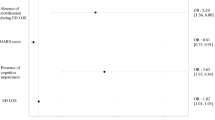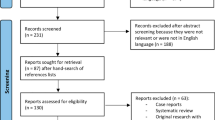Abstract
Background
With the increase in the proportion of elderly Lebanese patients, little is known about delirium’s prevalence, incidence and correlated factors.
Aims
To identify the prevalence, incidence and factors associated with overall and incident delirium in hospitalized elderly Lebanese patients.
Methods
A convenient sample was recruited from three university hospitals affiliated to the Lebanese university faculty of medical sciences. We included patients aged more than 65 years. Baseline factors were examined upon presentation and the confusion assessment method (CAM) was used to detect prevalent delirium upon admission or within the first 48 h. Enrolled patients were then assessed every other day to detect incident delirium cases.
Results
Among the 230 patients included, delirium prevalence was 17% and incidence 8.7%. We found that a history of falls (odds ratio (OR) = 5.12; p = 0.001), immobilization (OR = 7.33; p = 0.035), polypharmacy (OR = 5.07; p = 0.026) along with tachycardia (OR = 6.94; p = 0.03) and severe anemia (OR = 12.5; p = 0.005) upon admission were significant factors associated with overall delirium (incident and prevalent delirium cases). Whereas, living alone was significantly associated with lower odds for overall delirium (OR = 0.03; p = 0.02). Moreover, current smoking (OR = 14; p = 0.02), low oxygen saturation (OR = 9.6; p = 0.008) and severe anemia (OR = 8.4; p = 0.013) upon admission remained significantly associated with higher odds for incident delirium along with urine catheter placement (OR = 7.8; p = 0.015).
Conclusion
Secondary to the burden of delirium and its impact on mortality among elderly population, trying to understand and adjust modifiable factors would promote more appropriate prevention strategies.
Similar content being viewed by others
References
Wilber ST, Ondrejka JE (2016) Altered mental status and delirium. Emerg Med Clin North Am 3:649–665. https://doi.org/10.1016/j.emc.2016.04.012
Bhat R, Rockwood K (2007) Delirium as a disorder of consciousness. J Neurol Neurosurg Psychiatry 78:1167–1170. https://doi.org/10.1136/jnnp.2007.115998
Lipowski ZJ (1983) Transient cognitive disorders (delirium, acute confusional states) in the elderly. Am J Psychiatry 140:1426–1436. https://doi.org/10.1016/S0140-6736(13)60688-1
Inouye SK, Westendorp RG, Saczynski JS (2014) Delirium in elderly people. Lancet 383:911–922. https://doi.org/10.1111/j.1532-5415.2006.00893.x
Dasgupta M, Dumbrell AC (2006) Preoperative risk assessment for delirium after noncardiac surgery: a systematic review. J Am Geriatr Soc 54:1578–1589. https://doi.org/10.1001/archinternmed.2007.4
Francis J, Martin D, Kapoor WN (1990) A prospective study of delirium in hospitalized elderly. JAMA 263:1097–1101
Leslie DL, Marcantonio ER, Zhang Y et al (2008) One-year health care costs associated with delirium in the elderly population. Arch Intern Med 168:27–32
Tosun Tasar P, Sahın S, Akcam NO et al (2018) Delirium is associated with increased mortality in the geriatric population. Int J Psychiatry clin Practice 3:200–205. https://doi.org/10.1080/13651501.2017.1406955
Andersson EM, Hallberg IR, Norberg A et al (2002) The meaning of acute confusional state from the perspective of elderly patients. Int J Geriatr Psychiatry 17:652–663. https://doi.org/10.1002/gps.682
Statistical bulletin [Ministry of Public Health, Republic of Lebanon] (2010). http://www.moph.gov.lb/StatBulletin2010/Links/Wizara%20Booklet2010.pdf. Accessed 14 Jan 2019
Inouye SK, Van Dyck CH, Alessi CA et al (1990) Clarifying confusion: the confusion assessment method. A new method for detection of delirium. Ann Intern Med 113:941–948
Siddiqi N, House AO, Holmes JD (2006) Occurrence and outcome of delirium in medical in-patients: a systematic literature review. Age Ageing 35:350–364. https://doi.org/10.1093/ageing/afl005
Morandi A, Jackson JC, Ely EW (2009) Delirium in the intensive care unit. Int Rev Psychiatry 21:43–58. https://doi.org/10.1080/09540260802675296
Cole MG (2004) Delirium in elderly patients. Am J Geriatr Psychiatry 12:7–21
Jones RN, Yang FM, Zhang Y et al (2006) Does educational attainment contribute to risk for delirium? A potential role for cognitive reserve. J Gerontol A Biol Sci Med Sci 61:1307–1311
Hessler JB, Brönner M, Etgen T et al (2015) Smoking increases the risk of delirium for older inpatients: a prospective population-based study. Gen Hosp Psychiatry 37:360–364
Hsieh SJ, Shum M, Lee AN et al (2013) Cigarette smoking as a risk factor for delirium in hospitalized and intensive care unit patients. A systematic review. Ann Am Thorac Soc 10:496–503
Tomlinson EJ, Phillips NM, Mohebbi M et al (2017) Risk factors for incident delirium in an acute general medical setting: a retrospective case–control study. J Clin Nurs 26:658–667
Hein C, Forgues A, Piau A et al (2014) Impact of polypharmacy on occurrence of delirium in elderly emergency patients. J Am Med Dir Assoc 15:850.e11–850.e15
Tune L, Carr S, Hoag E et al (1992) Anticholinergic effects of drugs commonly prescribed for the elderly: potential means for assessing risk of delirium. Am J Psychiatry 149:1393–1394
Levinoff E, Try A, Chabot J et al (2018) Precipitants of delirium in older inpatients admitted in surgery for post-fall hip fracture: an observational study. J Frailty Aging 7:34–39
Boorsma M, Joling KJ, Frijters DH et al (2012) The prevalence, incidence and risk factors for delirium in dutch nursing homes and residential care homes. Int J Geriatr Psychiatry 27:709–715
Korc-Grodzicki B, Sun SW, Zhou Q et al (2015) Geriatric assessment as a predictor of delirium and other outcomes in elderly patients with cancer. Ann Surg 261:1085–1090
Yogaratnam J, Jacob R, Naik S et al (2013) Prolonged delirium secondary to hypoxic-ischemic encephalopathy following cardiac arrest. Clin Psychopharmacol Neurosci 11:39–42
Janz DR, Abel TW, Jackson JC et al (2010) Brain autopsy findings in intensive care unit patients previously suffering from delirium: a pilot study. J Crit Care 25:538.e7–538.e12
Fields A, Huang J, Schroeder D et al (2018) Agitation in adults in the post-anaesthesia care unit after general anaesthesia. Br J Anaesth 121:1052–1058
Boettger S, Jenewein J, Breitbart W (2015) Delirium and severe illness: etiologies, severity of delirium and phenomenological differences. Palliat Support Care 13:1087–1092
Heppner HJ, Cornel S, Peter W et al (2013) Infections in the elderly. Crit Care Clin 29:757–774
Lliffe S, Tai S, Haines A et al (1992) Are elderly people living alone an at risk group? BMJ 305:1001–1004
El Zoghbi M, Boulos C, Awada S et al (2014) Prevalence of malnutrition and its correlates in older adults living in long stay institutions situated in Beirut. Lebanon J Res Health Sci 14:11–17
Doumit JH, Nasser RN, Hanna DR (2014) Nutritional and health status among nursing home residents in Lebanon: comparison across gender in a national cross sectional study. BMC Public Health 14:629. https://doi.org/10.1186/1471-2458-14-629
Chahine LM, Bijlsma A, Hospers AP et al (2007) Dementia and depression among nursing home residents in Lebanon: a pilot study. Int J Geriatr Psychiatry 22:283–285
Mosk CA, Mus M, Vroemen JP et al (2017) Dementia and delirium, the outcomes in elderly hip fracture patients. Clin Interv Aging 12:421–430. https://doi.org/10.2147/CIA.S115945
Chen YL, Lin HC, Lin KH et al (2015) Low hemoglobin level is associated with the development of delirium after hepatectomy for hepatocellular carcinoma patients. PLoS One 10:e0119199. https://doi.org/10.1371/journal.pone.0119199
Marcantonio ER, Goldman L, Orav EJ et al (1998) The association of intraoperative factors with the development of postoperative delirium. Am J Med 105:380–384
Salluh JI, Wang H, Schneider EB et al (2015) Outcome of delirium in critically ill patients: systematic review and meta-analysis. BMJ 350:h2538. https://doi.org/10.1136/bmj.h2538
Witlox J, Eurelings LS, de Jonghe JF et al (2010) Delirium in elderly patients and the risk of postdischarge mortality, institutionalization, and dementia: a meta-analysis. JAMA 304:443–451. https://doi.org/10.1001/jama.2010.1013
Yue J, Tabloski P, Dowal SL et al (2014) NICE to HELP: operationalizing National Institute for Health and Clinical Excellence guidelines to improve clinical practice. J Am Geriatr Soc 62:754–761. https://doi.org/10.1111/jgs.12768
Funding
This research did not receive any funding or grants from any source.
Author information
Authors and Affiliations
Corresponding author
Ethics declarations
Conflicts of interest
The authors declare that they have no conflict of interest.
Statement of human and animal rights
This study has been approved by the institutional review board committees (IRB) of the involved hospitals and has therefore been performed in accordance with the ethical standards laid down in the 1975 declaration of Helsinki and its later amendments.
Informed consent
A written informed consent was obtained from each patient or from a first degree family member.
Additional information
Publisher's Note
Springer Nature remains neutral with regard to jurisdictional claims in published maps and institutional affiliations.
Electronic supplementary material
Below is the link to the electronic supplementary material.
Rights and permissions
About this article
Cite this article
Zrour, C., Haddad, R., Zoghbi, M. et al. Prospective, multi-centric benchmark study assessing delirium: prevalence, incidence and its correlates in hospitalized elderly Lebanese patients. Aging Clin Exp Res 32, 689–697 (2020). https://doi.org/10.1007/s40520-019-01242-2
Received:
Accepted:
Published:
Issue Date:
DOI: https://doi.org/10.1007/s40520-019-01242-2




